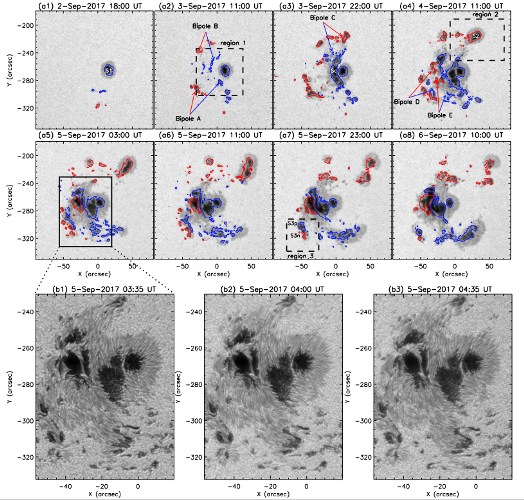Ph.D student LI Qiaoling, Prof.YAN Xiaoli and other researchers from Fuxian lake solar observatory of Yunnan Observatories, analyzed the formation and decay process of sunspot penumbra in the active region NOAA 12673.The results were recently published in The Astrophysical Journal.
A mature sunspot generally consists of a dark umbra in the center and a relative brighter penumbra. The appearance of penumbra is the criterion to distinguish sunspot from pore. Sunspots exhibit a strong magnetic field. When there are many sunspots on the surface of the Sun, other solar activities become more frequent. Sunspot is the best object to study magnetohydrostatic equilibrium, and the research on the evolution of sunspots can help to understand the relationship between sunspot and other solar activity phenomena, which is of great significance to the exploration and prediction of solar activity.
The evolution process of sunspot’s penumbra in active region NOAA 12673 has been studied in detail by using the data that observed by the new vacuum meter telescope (NVST) and Helioseismic and Magnetic Imager (HMI) onboard the Solar Dynamic Observatory (SDO).
Through the analysis of the sunspot magnetic field during the evolution of penumbra, researchers find that the mean longitudinal magnetic strength of penumbra decreased and its mean transverse magnetic strength increased with the increasing penumbral area during the formation of sunspots.
However, during the decay of sunspots, the mean longitudinal magnetic strength in the penumbra increased, and the mean transverse magnetic strength in the penumbra decreased with decreasing penumbral area. The newly emerging magnetosphere tube is suppressed and converges by the existing magnetic field to form the sunspot penumbra, and the change of the penumbral magnetic field from horizontal to vertical cause the disappearance of the sunspot penumbra, as shown in figure 1.
Through the analysis of the velocity field of sunspot penumbra, they find that moat flow around the periphery of sunspot gradually formed during the formation of the sunspot penumbra. In the process of penumbral decay, the velocity of moat flow near the region of magnetic emergence gradually decreased and disappeared first.
Moreover, it is also found that the magnetic field environment around the sunspot may affect the sunspot lifetime.

Figure 1: High-resolution TiO images observed by the NVST and Continuum intensity images observed by SDO /HMI showing the sunspot evolution of Active Region NOAA 12673.(Image by LI Qiaoling )
Contact:
YAN Xiaoli
Yunnan Observatories , CAS
yanxl@ynao.ac.cn